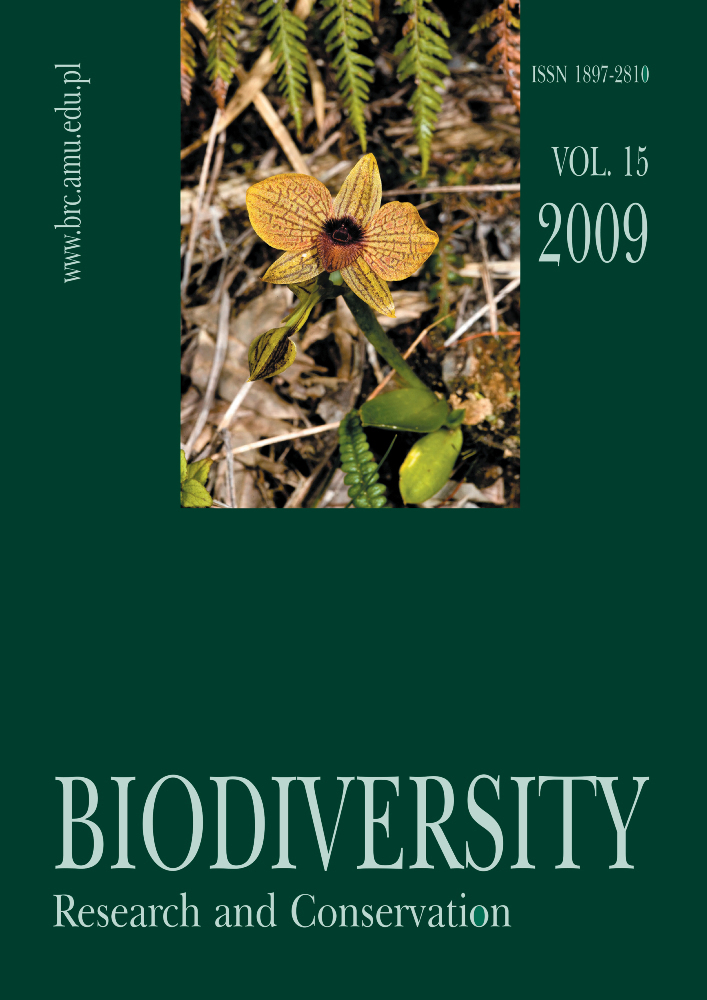Abstract
Genetic diversity was analyzed in 19 ecotypes of the diploid oat A. strigosa originating from various geographical regions of the world. Six isoenzyme systems (AAT, ACP, EST, LAP, MDH, PX) were studied and 16 loci were identified. Only two loci (Est4 and Mdh2) were polymorphic. Ecotypes were characterized by the percentage of polymorphic loci (P=3.3%), the mean number of alleles per locus (A=1.04) and intrapopulation diversity (HS=0.013). Total genetic diversity (HT=0.07) and interpopulation diversity (DST=0.057) were examined as well. The value of the coefficient of gene differentiation (GST=0.821) indicated that diversity among populations was an important contributor to total variability. Genetic similarity between A. strigosa populations was very high (IN=0.94). Cluster analysis did not demonstrate strongly differentiated groups among the ecotypes examined.
References
Bauer P. J. & Reeves D. W. 1999. A comparison of winter cereal species and planting dates as residue cover for cotton grown with conservation tillage. Crop Sci. 39: 1824-1830.
Baum B. R. 1977. Oats: wild and cultivated. A monograph of the genus Avena L. (Poaceae). Biosystematics Research Institute Monograph 14, pp. 1-463. Canada Department of Agriculture, Ministry of Supply and Services, Ottawa, Canada.
Charmet G. & Balfourier F. 1994. Isozyme variation and species relationships in the genus Lolium L. (ryegrasses, Graminaceae). Theor. Appl. Genet. 87: 641-649.
Diaz O., Salomon B. & Bothmer R. 1999. Genetic variation and differentiation in Nordic populations of Elymus alaskanus (Scrib. Ex merr.) Löwe (Poaceae). Theor. Appl. Genet. 99: 210-217.
Doebley J. 1990. Isozymic evidence and the evolution of crop species. In: D. E. Soltis & P. S. Soltis (eds.). Isozymes in Plant Biology, pp. 165-191. Dioscorides Press, Portland, Oregon.
Frey L. 1989. Rozmieszczenie Avena strigosa Schreb. w Polsce. Fragm. Flor. Geobot. 34: 43-51.
Frey L. 1991. Distribution of Avena strigosa (Poaceae) in Europe. Fragm. Flor. Geobot. 36: 281-288.
Gitzendanner M. A. & Soltis P. S. 2000. Patterns of genetic variation in rare and widespread plant congeners. Amer. J. Bot. 87: 783-792.
Guma I. R., Pérez de la Vega M. & García P. 2006. Isozyme variation and genetic structure of populations of Avena barbata from Argentina. Genet. Resour. Crop Evol. 53: 587-601.
Hamrick J. L. 1989. Isozymes and the analysis of genetic structure. In: D. E. Soltis & P. S. Soltis (eds.). Isozymes in Plant Biology, pp. 87-105. Dioscorides Press, Portland, Oregon.
Hamrick J. L. & Godt M. J. W. 1989. Allozyme diversity in plant species. In: A. H. D. Brown, M. T. Clegg, A. L. Kahler & B. S. Weir (eds.). Plant Population Genetics, Breeding, and Genetic Resources, pp. 3-63. Sinauer, Sunderland.
Kieć J. 2003. The occurrence of Avena strigosa on arable fields on south-eastern Poland. Biul. IHAR 229: 229-234.
Kornaś J. 1987a. Chwasty polne rozprzestrzeniane z materiałem siewnym. Zesz. Nauk. Akad. Rol. Krak. 19: 23-36.
Kornaś J. 1987b. Zmiany roślinności segetalnej w Gorcach, w ostatnich 35 latach. Zesz. Nauk. Uniw. Jagiell. 834, Prac. Bot. 15: 7-26.
Korniak T. 1997. Avena strigosa (Poaceae) in north-eastern Poland. Fragm. Flor. Geobot. 42: 201-206.
Korniak T. & Frey L. 1999. Morphology and infraspecific variability of Avena strigosa (Poaceae) in north-eastern Poland. Fragm. Flor. Geobot. Suppl. 7: 5-12.
Korniak T. & Kuszewska K. 1999. Owies szorstki (Avena strigosa Schreb.) - zapomniana roślina uprawna. Zesz. Prob. Post. Nauk Rol. 468: 95-102.
Kropač Z. 1981. Avena strigosa - a disappearing synanthropic species in Czechoslovakia. Preslia (Praha) 53: 305-321.
Loskutov I. G. 2007. On the taxonomy of genus Avena L. http://www.vir.nw.ru/books/list2.htm
Maki M. 2003. Population genetics of threatened wild plants in Japan. J. Plant Res. 116: 169-174.
Miczyński K. 1949-1950. Owies szorstki (Avena strigosa Schreb.) - zanikająca roślina uprawna w powiecie nowotarskim [Bristle oat (Avena strigosa Schreb.) - a disappearing crop in the Nowy Targ county]. Acta Soc. Bot. Pol. 20: 155-165.
Morikawa T. & Leggett J. M. 1990. Isozyme polymorphism in natural populations of Avena canariensies from Canary Islands. Heredity 64: 403-411.
Nie M. 1978. Estimation of average heterozygosity and genetic distance from a small number of individuals. Genetics 89: 583-590.
Oja T. 1999. Allozyme diversity and interspecific differentiation of the two diploid bromegrass species, Bromus tectorum L. and B. sterilis L. (Poaceae). Plant Biol. 1: 679-686.
Sneath P. H. & Sokal R. R. 1973. Numerical taxomony: the principles and practice of numerical classification. Freeman W. H. and Co., San Francisco.
Suttie J. M. & Reynolds S. G. 2004. Fodder oats: a world overview. Plant Prod. and Prot. 33. FAO Rome: http://www.fao.org/docrep/008/y5765e/y5765e00.htm.
Warcholińska A. U. 1994. List of threatened segetal plant species in Poland. In: S. Mochnacký & A. Terpo (eds.). Antrophization and environment of rural settlements. Flora and vegetation. Proceedings of International Conference, Sátoraljaú, Slovakia, Košice, pp. 206-219.
Weibull J., Bojensen L. L. J. & Rasomavicius V. 2002. Avena strigosa in Denmark and Lithuania: prospects for in situ conservation. PGR Newsletter 131: 1-6.
Wendel J. F. & Weeden N. F. 1989. Visualization and interpretation of plant isoenzyme. In: D. E. Soltis & P. S. Soltis (eds.). Isozymes in Plant Biology, pp. 5-45. Dioscorides Press, Portland, Oregon.
Yeh F. C., Yang R. 1999. POPGENE 1.31. Microsoft Windows-based freeware for population genetic analysis.
Zieliński R. 1987. Genetic variation of the liverwort genus Pellia with special reference to central European territory. Wyd. Nauk. Uniw. Szczeciń. 108(24): 1-297.




